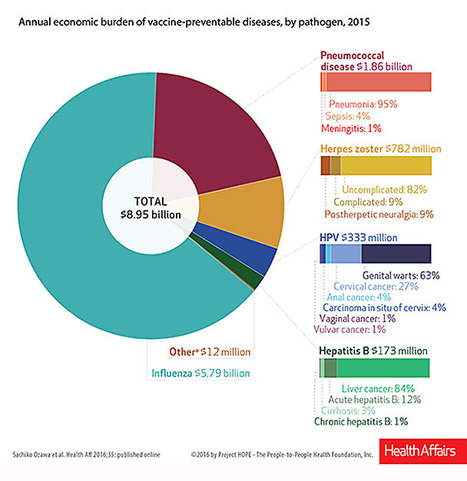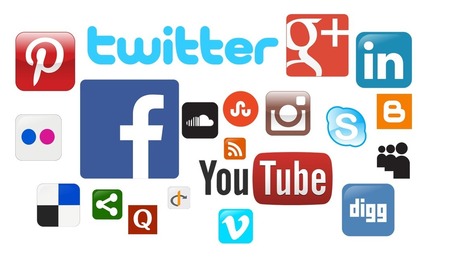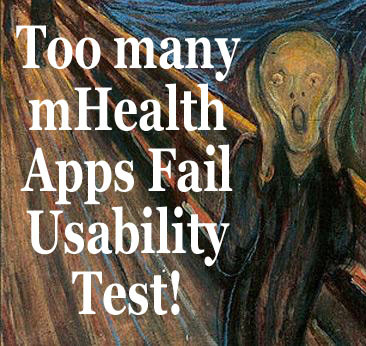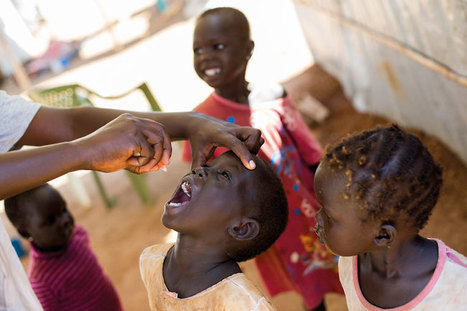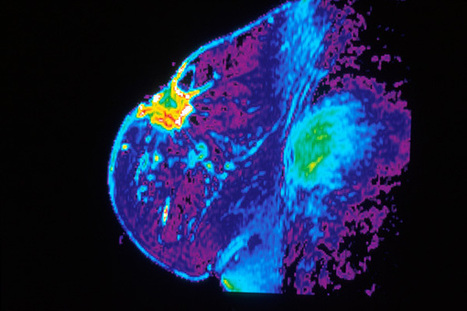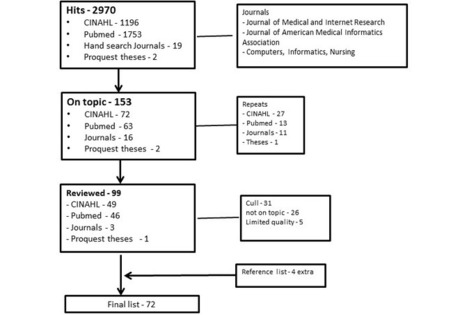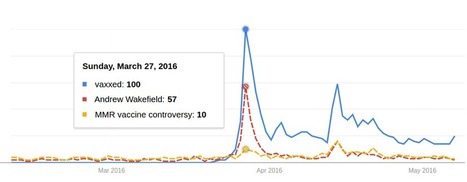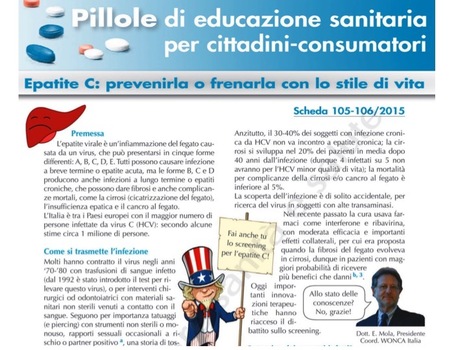 Your new post is loading...
 Your new post is loading...

|
Scooped by
Giuseppe Fattori
October 23, 2016 8:24 AM
|
Vaccines save thousands of lives in the United States every year, but many adults remain unvaccinated. Low rates of vaccine uptake lead to costs to individuals and society in terms of deaths and disabilities, which are avoidable, and they create economic losses from doctor visits, hospitalizations, and lost income. To identify the magnitude of this problem, we calculated the current economic burden that is attributable to vaccine-preventable diseases among US adults. We estimated the total remaining economic burden at approximately $9 billion (plausibility range: $4.7–$15.2 billion) in a single year, 2015, from vaccine-preventable diseases related to ten vaccines recommended for adults ages nineteen and older. Unvaccinated individuals are responsible for almost 80 percent, or $7.1 billion, of the financial burden. Sixty-five percent of the estimated annual economic burden, equivalent to $5.8 billion (plausibility range: $2.0–$11.6 billion), resulted from influenza alone—a vaccine-preventable disease that causes substantial numbers of hospitalizations and morbidity each year. It should be noted that this study examined a static annual estimate of the unvaccinated cohort, and therefore not all cases in this group are necessarily preventable by increased vaccination because of less than 100 percent vaccine efficacy.
Via Pharma Guy

|
Scooped by
Giuseppe Fattori
October 11, 2016 4:41 PM
|
Most hospitals offer palliative-care services that help people with serious illnesses manage their pain and other symptoms and make decisions about their treatment while providing emotional support and assistance in navigating the health-care system. But the majority of these programs fail to meet national guidelines for staffing, a recent study found.

|
Scooped by
Giuseppe Fattori
October 11, 2016 4:27 PM
|
The global public health initiative to eradicate polio is "not a done deal." That's the consensus at the 2016 World Health Summit in Berlin. There is plenty of potential for us to fail. On three counts. If it weren't for the short-sightedness of business, we may not be in the situation we are with polio today. In the late 1990s we were heading towards a global public health goal of eradicating the disease by the year 2000. By 1999, things were looking good. And the World Health Organization says one strand - poliovirus type 2 - was indeed eradicated that year.
But Suraya Dalil, the Afghan ambassador to Switzerland, suggests commercial concerns at the time may have led us to where we are now.
"We wanted to eradicate polio by 2000," says Dalil. "I remember I was at UNICEF. But the [stock of] polio vaccine was very low because the manufacturers weren't making it, thinking that by 2000 no one would buy it."
And sixteen years later, says Dalil, we still face a global threat. Her home country, Afghanistan, and Pakistan are listed by the WHO as the two places in the world where polio transmission has never stopped.

|
Scooped by
Giuseppe Fattori
September 2, 2016 1:00 AM
|
Researchers have enrolled 2,000 people with metastatic breast cancer in 7 months using a social media-enabled, direct-to-patient model of recruiting. The study is using social media and blogs to drive patients to a website where they can consent to share medical records and genomic data with the researchers. A team from the Broad Institute and the Dana-Farber Cancer Institute set up the study to address the lack of genomic data from the tumors of patients with metastatic breast cancer. This situation is a consequence of many breast cancer patients being treated in community care settings. Faced with this shortfall in knowledge, the researchers designed a study that allows patients to consent to share parts of their tumor biopsies, medical records and saliva samples using at-home spit kits. The design of the data-gathering elements of the trial free participants from the need to visit a study site. This makes it easier for the researchers to enroll subjects, but only if they can contact patients and persuade them of the value of participating. Like Pfizer ($PFE) before it, the Broad/Dana-Farber team has used social media to enroll subjects in its virtual trial. But, while the approach proved to be flawed for Pfizer’s trial, the strategy pursued by Broad and Dana-Farber is working for its study.
A new UCSF study finds that some of the most popular apps for diabetes, depression and caregivers are too difficult to use, especially by underserved populations. The study, published this week in the Journal of General Internal Medicine, finds that the apps aren’t easy to use, especially by low-income and underserved users who should be their target audience. And if they’re too difficult, the user will get frustrated and ditch them. Gourley and Urmimala Sarkar, MD, a UCSF associate professor of medicine, led a team of researchers in the study at The Priscilla Chan and Mark Zuckerberg San Francisco General Hospital and Trauma Center, a UCSF partner hospital. The team introduced 26 patients to three or four apps apiece, each focused on their condition, be it diabetes or depression; some of the users were caregivers to elderly patients, and were asked to try caregiver apps. In many cases, patients had difficulty accessing features or entering data, and in almost every case the patient didn’t get far enough to use that data. Over the course of the study, the patients only completed about half of the data-entry tasks, and only 43 percent were able to retrieve data from the apps. “We have such a great opportunity now for patients to use mobile technology to interact with their medical providers and to become more involved in their own care – which we know results in improved health outcomes,” Sarkar said in the press release. “Nowhere is this more important than for vulnerable populations who often suffer disproportionately from a multitude of chronic, serious conditions. If we can give them the tools to manage their health between medical visits, the benefits could be tremendous.”
Via Pharma Guy

|
Scooped by
Giuseppe Fattori
July 15, 2016 7:45 PM
|
Marketing Sociale - Newsletter 140

|
Scooped by
Giuseppe Fattori
July 15, 2016 4:56 PM
|
SUMMARY Objectives: reflecting upon which incentives social marketing and health education are based on, and their differences and interconnections becomes essential to promote healthy lifestyles and ensure a free and sustainable future. Methods: in order to promote health, it is necessary to use all the incentives that contribute to achieving this end. Health education, social marketing and laws (expression of the policy) are to be considered the functional medium of health promotion to be used generally or individually, according to the targets/contexts. Results: the methods used to promote health are work in progress, the Community Based Prevention Marketing is such an expression. Conclusions: considering health as a resource for everyday life means externalizing it from what is seen as the sole responsibility of the health system. Health should become the purpose of actions which, through cross-sector synergies, concern the different components of civil society, particularly political agendas.

|
Scooped by
Giuseppe Fattori
May 23, 2016 2:14 PM
|
It’s like a FitBit for your sweat, detecting your blood alcohol level. Skyn is a wristband from breathalyser company BACtrack, and it detects alcohol using a fuel cell technology not unlike that used by your friendly roadside RBT. The device is worn on the wrist and offers continuous, real-time, and non-invasive monitoring of your TAC (Transdermal Alcohol Content). Alcohol is detected and measured with transdermal monitoring, which tracks the ethanol molecules escaping through the skin. TAC samples are then converted into a history of your BAC (Blood Alcohol Content) with BACtrack’s proprietary algorithm. BACtrack Skyn uses an electrochemical sensor and connects via Bluetooth to an app on your smartphone. Since it can take up to 45 minutes for alcohol to be transmitted through the skin its accuracy for some applications (like replacing traditional breathalysers) is unreliable. But what it can reliably be used for is continuous monitoring. You can relay data to your doctor, it can warn you if you’ve had too much to drink. Basically, you can passively track alcohol consumption in real-time. There’s no need to take a breath alcohol test — your estimated BAC result is on their wrist, continuously. For instance, your phone could vibrate to notify you that you’re approaching 0.04 per cent BAC and remind you to slow down your drinking. If you’re aiming for sobriety, a nominated contact could receive a notification when your BAC has gone above 0.00 per cent. Based in San Francisco, BACtrack won the “Wearable Alcohol Biosensor Challenge” competition held by the National Institute on Alcohol Abuse and Alcoholism with the Skyn, which came with a $200,000 prize. The competition aimed to uncover wearable technologies that can be used comfortably by everyday people, and was judged on accuracy. “A limited quantity” of Skyn devices with be available later in the year, says BACtrack, who have opened registrations for pre-order availability notifications.

|
Scooped by
Giuseppe Fattori
May 22, 2016 11:39 AM
|
The Preamble of the Constitution of the World Health Organization reminds us that «Informed opinion and active cooperation on the part of the public are of the utmost importance in the improvement of the health of the people» (Grad, 2002). Nonetheless, nearly seven decades later, the conditions under which people can be informed and actively participate in their health management in a meaningful way are being globally challenged. Drawing from experience in a variety of areas that I will delve into in this article, I remain a believer that we can marshal the necessary forces to advance the communication of health issues and create a base for a health-literate population to make smart(er), healthier decisions that advance health and well-being. Keywords: health communication, health literacy, Ebola, vaccines, innovation. The ultimate goal of health communication is to advance an informed and empowered individual who can make smart choices for themselves, their families and communities whether it be in daily life, business and/or public policy. While the goal and practice may seem elusive, a simple fundamental tenet is that we need to advance our communication prowess to develop health literacy from individuals to the body politic. Ideally, an ethical, evidence-based communication approach can build upon historical challenges of how we address issues in science and health – from creationism to the heliocentric theory of the universe to nuclear physics to climate change. While Darwin, Galileo, Copernicus and others challenged the conventional wisdom and the «faith-based» approach of their time, countless others joined then and now in advancing science-based approaches to make the world a better place.

|
Rescooped by
Giuseppe Fattori
from Cancer Contribution
May 21, 2016 10:54 AM
|
(AFP) - Le Haute autorité de santé (HAS) s'est prononcé contre le dépistage systématique du cancer du poumon par scanner chez les fumeurs, estimant que les conditions n'étaient pas réunies à ce stade pour un tel dépistage.Sollicitée pa...
Via Giovanna Marsico

|
Scooped by
Giuseppe Fattori
May 16, 2016 1:49 AM
|
According to a Pew Research Center report released last month, Americans are engaged and connected like never before. Nearly 70 percent own a smartphone, and 45 percent have a tablet-like device. It’s clear that almost all of us interact with mobile devices on a daily basis. Wearable sensor technology as well as connected watches and other mobile monitors are becoming more commonplace. And these new devices have the potential to significantly impact health care delivery in the U.S. today.

|
Scooped by
Giuseppe Fattori
May 15, 2016 12:45 PM
|
Drinking diet (or sugar free) fizzy drinks during pregnancy makes women more likely to give birth to overweight children, according to research from the University of Manitoba in Canada. The researchers found that mothers who drink sugar free, artificially sweetened beverages during pregnancy are twice as likely to have an overweight baby by the age of 12 months. The findings suggest the possibility that children who are exposed to artificial sweeteners in the womb could develop a sweet tooth, leading them to eat foods higher in calories — but cautioned that this was not a biological study, and that they had merely observed a link.
|

|
Rescooped by
Giuseppe Fattori
from Patient Hub
October 19, 2016 1:38 PM
|
Une étude canadienne récente semble montrer que les médias sociaux auraient un impact favorable chez les jeunes adultes dans l’arrêt du tabac. Arrêter de fumer n’est jamais simple et un coup de pouce est souvent nécessaire. En effet, les addictions telles que le tabagisme ou l’alcoolisme passent par le circuit de la récompense, lequel a un rôle majeur dans nos comportements alimentaires, sexuels et sociaux. Il fait notamment intervenir la dopamine connue comme l’une des hormones du bonheur. Ainsi, fumer procure une sensation de bien-être chez les fumeurs rendant difficile l’arrêt du tabac. D’un autre côté, Internet est partout et les médias sociaux (dont les réseaux sociaux) ont envahi notre quotidien. Des chercheurs canadiens – des universités de Toronto et deWaterloo, de la société canadienne du cancer et du CENSE Research + Design – se sont donc demandé quel pourrait être l’impact d’une campagne pour arrêter de fumer sur les médias sociaux. Par ailleurs, les jeunes adultes (19-29 ans) sont très présents en ligne, et le ciblage sur les médias sociaux est relativement aisé. Les chercheurs ont donc pu concentrer leur étude sur cette tranche de la population et obtenir des données spécifiques la concernant.
Via Vigipharm, Philippe Marchal

|
Scooped by
Giuseppe Fattori
October 12, 2016 1:50 AM
|
You may have read or heard about the study debunking the five-second rule. It said that no matter how fast you pick up food that falls on the floor, you will pick up bacteria with it. Our continued focus on this threat has long baffled me. Why are we so worried about the floor? So many other things are more dangerous than that. I first became interested in the five-second rule years ago, when I was a co-author of a book on medical myths. We cited a number of studiesshowing that food that touched household surfaces — even for brief periods of time — could pick up bacteria or other harmful substances. This most recent study was similar in that it tested a variety of foods, a variety of substances, for various periods. And, like those other studies, this one found that food touching the floor, even for a very short amount of time, could pick up bacteria.

|
Scooped by
Giuseppe Fattori
October 11, 2016 4:40 PM
|
The Coca-Cola Company and PepsiCo have donated millions of dollars to organizations that promote health. Sugary sodas are considered to be among the main factors behind the obesity epidemic and tooth decay, raising questions about whether health and medical organizations should accept manufacturers' donations.

|
Scooped by
Giuseppe Fattori
September 4, 2016 4:36 PM
|
A study led by Harvard Medical School investigators at Massachusetts General Hospital reveals how spontaneous changes in the molecular characteristics of tumors can lead to tumors with a mixed population of cells requiring treatment with several types of therapeutic drugs. Get more HMS news here In their report in Nature, the research team describes finding a mixture of HER2-positive and HER2-negative circulating tumors cells (CTCs) in blood samples from patients who developed metastatic disease after originally being diagnosed with estrogen-receptor (ER)-positive/HER2-negative breast cancer. "This population of tumor cells is able to spontaneously oscillate between HER2-positive and HER2-negative states."—Shyamala Maheswaran
“Not only did we observe the acquisition of HER2 positivity in patients with ER-positive/HER2 negative breast tumors, we also found that this population of tumor cells is able to spontaneously oscillate between HER2-positive and HER2-negative states, which contributes to tumor progression and resistance,” said Shyamala Maheswaran, HMS associate professor of surgery at Mass General and co-senior author of the paper. “We also showed in mouse models the types of therapies that may be most useful for patients with these difficult-to-treat tumors.”

|
Scooped by
Giuseppe Fattori
September 1, 2016 3:51 PM
|
Osteoarthritis — the age-related, “wear-and-tear” form of joint disease — is the most common type of arthritis. And the knee is the most commonly affected joint. In fact, almost half of the population will have knee pain due to osteoarthritis by age 85. There is no cure; the only permanent treatment is a total knee replacement. More than 700,000 of these operations are performed in the U.S. each year, and the rate of knee replacement surgery has nearly doubled between 2000 and 2010. Since surgery is a last resort, what can you do in the meantime? The mainstays of treatment include losing weight if you need to, exercise, various pain relievers and anti-inflammatory medications, and physical therapy. But these approaches don’t always work well. If they did, we’d have far fewer joint replacement surgeries! Considering how common osteoarthritis of the knee is and how limited our treatments are, news of a novel approach to treating osteoarthritis of the knee comes none too soon.

|
Scooped by
Giuseppe Fattori
July 18, 2016 1:00 AM
|
ABSTRACT Background: Prevailing health care structures and cultures restrict intraprofessional communication, inhibiting knowledge dissemination and impacting the translation of research into practice. Virtual communities may facilitate professional networking and knowledge sharing in and between health care disciplines. Objectives: This study aimed to review the literature on the use of social media by health care professionals in developing virtual communities that facilitate professional networking, knowledge sharing, and evidence-informed practice. Methods: An integrative literature review was conducted to identify research published between 1990 and 2015. Search strategies sourced electronic databases (PubMed, CINAHL), snowball references, and tables of contents of 3 journals. Papers that evaluated social media use by health care professionals (unless within an education framework) using any research design (except for research protocols or narrative reviews) were included. Standardized data extraction and quality assessment tools were used. Results: Overall, 72 studies were included: 44 qualitative (including 2 ethnographies, 26 qualitative descriptive, and 1 Q-sort) and 20 mixed-methods studies, and 8 literature reviews. The most common methods of data collection were Web-based observation (n=39), surveys (n=23), interviews (n=11), focus groups (n=2), and diaries (n=1). Study quality was mixed. Social media studied included Listservs (n=22), Twitter (n=18), general social media (n=17), discussion forums (n=7), Web 2.0 (n=3), virtual community of practice (n=3), wiki (n=1), and Facebook (n=1). A range of health care professionals were sampled in the studies, including physicians (n=24), nurses (n=15), allied health professionals (n=14), followed by health care professionals in general (n=8), a multidisciplinary clinical specialty area (n=9), and midwives (n=2). Of 36 virtual communities, 31 were monodiscipline for a discrete clinical specialty. Population uptake by the target group ranged from 1.6% to 29% (n=4). Evaluation using related theories of “planned behavior” and the “technology acceptance model” (n=3) suggests that social media use is mediated by an individual’s positive attitude toward and accessibility of the media, which is reinforced by credible peers. The most common reason to establish a virtual community was to create a forum where relevant specialty knowledge could be shared and professional issues discussed (n=17). Most members demonstrated low posting behaviors but more frequent reading or accessing behaviors. The most common Web-based activity was request for and supply of specialty-specific clinical information. This knowledge sharing is facilitated by a Web-based culture of collectivism, reciprocity, and a respectful noncompetitive environment. Findings suggest that health care professionals view virtual communities as valuable knowledge portals for sourcing clinically relevant and quality information that enables them to make more informed practice decisions. Conclusions: There is emerging evidence that health care professionals use social media to develop virtual communities to share domain knowledge. These virtual communities, however, currently reflect tribal behaviors of clinicians that may continue to limit knowledge sharing. Further research is required to evaluate the effects of social media on knowledge distribution in clinical practice and importantly whether patient outcomes are significantly improved.

|
Scooped by
Giuseppe Fattori
July 15, 2016 6:14 PM
|

|
Rescooped by
Giuseppe Fattori
from Cancer Contribution
May 23, 2016 2:55 PM
|
L'assureur français Axa a décidé lundi de se débarrasser de ses propres actifs liés au tabac, qui pèsent environ 1,8 milliard d'euros, une grande première dans le secteur de l'assurance saluée par des défenseurs de la lutte contre le tabagisme et des promoteurs de l'investissement durable. "La poursuite de nos investissements dans des entreprises de l'industrie du tabac n'a plus de sens", a expliqué l'Allemand Thomas Buberl, qui prendra les rênes du groupe dès septembre. Axa, dont l'ensemble des primes santé s'est élevé à "près de 12 milliards d'euros" en 2015, est le "premier assureur global" à faire ce choix, a affirmé à l'AFP un porte-parole de l'entreprise. Le groupe, qui se présente comme un "assureur santé et investisseur responsable", souhaite jouer un rôle dans la "prévention" et "soutenir les efforts des gouvernements" de la planète pour enrayer le tabac et ses effets désastreux sur la santé, selon un communiqué. "Cette décision a un coût, mais notre conviction est claire: le coût humain du tabac est dramatique, son coût économique est énorme", écrit M. Buberl dans ce document. Axa, qui avait annoncé le retrait de ses investissements dans le secteur du charbon à hauteur d'environ 500 millions d'euros, il y a tout juste un an en vue de la COP21, va cette fois encore plus loin dans sa politique d'investissement responsable. La compagnie d'assurances, qui s'est engagée l'an dernier à tripler ses investissements "verts" d'ici 2020, va "immédiatement céder" les actions qu'elle détient dans des entreprises du secteur du tabac, et dont la valeur actuelle s'élève à environ 200 millions d'euros.
Via Giovanna Marsico

|
Scooped by
Giuseppe Fattori
May 23, 2016 1:00 PM
|
Editor's Note: PLOSBLOGS invited independent science journalist Beth Skwarecki to assess and contextualize the controversy which errupted in the US surrounding last month's release of Vaxxed, a documentary film made by and about anti-vaccine proponent and discredited doctor Andrew Wakefield. Our purpose in publishing the post that follows is not to review this film (problematic in any event since preview copies were not made available to press), but rather to provide a context for the reignited debate about vaccines that it has already provoked--and may still cause as its distribution expands to Asia. We want to help our readers--including parents attempting to make the correct decision about vaccinating their children, public health providers responding to vaccine hesitancy on the part of worried parents and public health researchers charged to provide evidence-based guidance on best practices for communicating vaccine efficacy and safety--to counter the current re-emergence of anti

|
Rescooped by
Giuseppe Fattori
from Pharma Hub
May 21, 2016 11:13 AM
|
Réseaux sociaux et pros de santé, ça vous évoque quoi ?Les réseaux sociaux ont pris une place croissante dans la vie des Français ces dernières années et les professionnels de santé n’y échappent pas. De plus en plus de communautés de médecins, infirmières ou pharmaciens émergent sur le web, de façon structurée avec des plateformes dédiées ou de manière spontanée et informelle sur les médias sociaux existants (groupe Facebook ou LinkedIn, hashtag sur twitter…). On constate aujourd’hui que les professionnels de santé, et notamment les médecins, ont de moins en moins de temps pour se rencontrer et échanger. Les réseaux sociaux répondent donc à différents besoins importants comme : la création d’un réseau de partenaires dans le cadre des parcours de soins (notamment pour les jeunes praticiens), le partage d’expertise et d’avis sur des cas patients ou l’échange autour de l’actualité médicale.
Via Philippe Marchal

|
Scooped by
Giuseppe Fattori
May 16, 2016 2:54 PM
|

|
Scooped by
Giuseppe Fattori
May 15, 2016 3:30 PM
|
One of the subtler sleights of hand used by obesity crusaders is to talk about obesity while using figures that refer to people who are obese or overweight. Health reporters do it all the time and subeditors frequently put the word ‘obesity’ in the headline when the story is actually about people who are overweight (see here and here, to pick two examples at random). Since there are more overweight people than there are obese people, the effect — and probably the intention — of this blurring of the lines is to inflate the number of supposed victims of the obesity ‘epidemic’. A quarter of Britons are obese, but if you add in people who are merely overweight this rises to 60 per cent.
|
 Your new post is loading...
Your new post is loading...
 Your new post is loading...
Your new post is loading...






